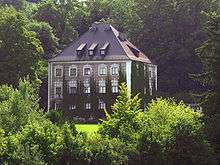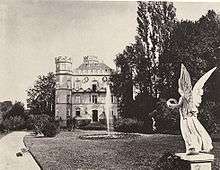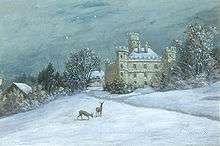Berg Castle (Bavaria)



Berg Castle (German: Schloss Berg) is a manor house situated on the east shore of Lake Starnberg in the village of Berg in Upper Bavaria, Germany. It is famous as the site of King Ludwig II of Bavaria's death. Today, it remains home to the head of the house of Wittelsbach, currently Franz, Duke of Bavaria.
History
Ferdinand Maria, Elector of Bavaria, acquired a piece of land on the shores of Lake Starnberg in 1676 from the Horwarth family and ordered the construction of Berg Castle. Ferdinand used it for festivities, but it reached its zenith under his successors, elector Max Emanuel and Emperor Charles VII, when it was the scene of spectacular entertainments and hunts.
Between 1849 and 1851 King Maximilian II instructed the architect Eduard Riedel to redesign the castle in Neo-Gothic style, with added crenellations and four towers, for which the king bought additional land. (Maximilian's son Ludwig II of Bavaria had a fifth tower constructed, which he called "Isolde"). In 1853 Maximilian had a small private harbour built.
Ludwig II used the castle as his summer residence, moving here regularly every year on 11 May and performing the business of state from it. For this purpose he had a telegraph connection installed between the castle and Munich.
In 1868 the Czarina of Russia Maria Alexandrovna visited Berg at the King's invitation. Ludwig gave her the castle to live in for the duration of her visit and had it magnificently decorated for the occasion: the castle was otherwise, by Ludwig's standards, rather modestly appointed.
The surrounding park had been treated by his predecessors in the fashions of the times, from a Baroque formal garden to an English landscaped garden. Ludwig had the "Moorish Kiosk" set up here which Franz von Seitz had designed and built for the Winter Garden on the roof of the Munich Residenz.[1]
In 1876 the King had a small chapel built.
On 12 June 1886, Ludwig, who shortly before had been declared medically incapable of ruling, with his uncle Luitpold appointed as Regent, was transported to Berg Castle. On June 13 he was found dead, floating in the shallow waters of Lake Starnberg near the shore, with his doctor Bernhard von Gudden. The deaths remain unexplained, despite an official explanation of drowning. A votive chapel and a memorial cross set in the lake form a memorial.
After the king's death the castle became a museum and in 1939 was declared a monument, as it had not been changed since Ludwig's death, and had thus acquired not only a historical but also a cultural significance.
After World War II, the castle was occupied by American soldiers, who damaged it severely, compounding previous damage caused by the war, especially to the corner towers. It was repaired and completely renovated from 1949 to 1951; the corner towers were entirely removed and the building was restored on the basis of what it had been before Maximilian's intervention, although the chapel was left. Albrecht, Duke of Bavaria then moved in and used it as his main residence until his death in 1996, upon which his eldest son Franz followed him as head of the House of Wittelsbach. However, Franz decided to live in Munich instead, where he occupies a wing of Nymphenburg Palace, but uses Berg Castle as his country retreat.
Notes and references
- ↑ It is not clear what became of this structure. This kiosk is not to be confused with the "Moorish Kiosk" at Schloss Linderhof, designed by Carl von Diebitsch for the 1867 Paris Exhibition.
Sources
| Wikimedia Commons has media related to Berg Castle (Bavaria). |